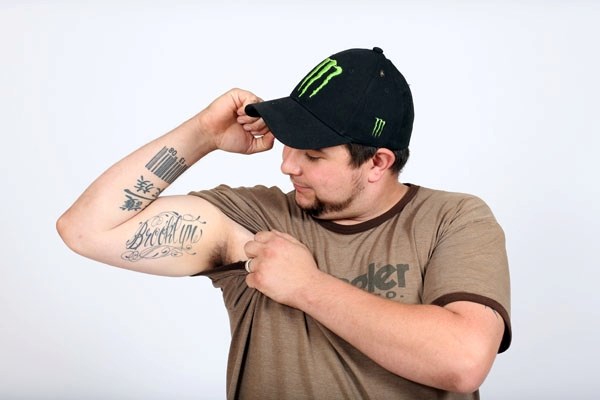Desiree Harvey’s interest in tattoos started early, and she was keen enough on the idea to try it on herself first. Her first ones were tiny ones done with a needle dipped in India ink, at the age of 14, with her friends and her “just being really young punks,” she laughs now.
But her experiments got more elaborate, as a couple of years later, she decided to make her own tattoo gun out of little more than a spoon, walkman batteries, a A/C bolt and a power cord. She used the gun to make a red arm band with vines extending from it, representing “the blood of man and the unity of nature.” Four rays extend from the band representing earth’s elements.
“It wasn’t too bad,” she said of her work, adding that three of 13 of her tattoos are her own work and she’s since done a few for friends.
“It instantly became an addiction,” she said. “I thought it’d be neat to decorate your temple, which I think is your body.”
Her first experience going to see a professional tattoo artist was at age 19, in Calgary. In her childhood, she’d often had visions or images come to her of an eye. “At first I was afraid of it, I thought it was kind of scary. But then I realized it was an all-seeing eye,” she said, realizing that for her, this was a representation of God, or the Creator. She drew the image and took it in to the tattoo artist, who recreated it for her.
“It is still my favorite tattoo. The guy did an amazing job. I love it,” she said. “Now I realize there’s nothing like a pro.” Some of her tattoos have been done in stages by friends and tattoo artists, a blend of different people’s work. But having done that, her advice for people considering getting a tattoo is to find an artist whose style they like and go through their portfolio before getting any work done.
For her, each of her choices reflects a story or a part of her identity. For instance, one tattoo of a tree shows three birds, one for each of her three children. Two crows, representing her youngest children, sit in the tree, while the third, a raven, is shown out of the tree, with the raven reflecting “a time of transition into deeper wisdom” as both she and her son are growing up and growing wiser. Another image, that of a scotch thistle, is an engagement tattoo that both her partner and her share. The thistle was the first flower he ever brought her shortly after they met, not knowing it was one of her favorites.
“It’s like a storybook,” she says of her various tattoos. “Every time somebody asks you about a tattoo, you say, ‘Yeah, I have to tell them the story behind it, what I was doing at that time in my life.’”
People update their houses, maybe putting in new throw cushions or curtains, she says, adding tattoos offer a similar sort of experience of “constant change.” She estimates she has spent roughly $2,000 on tattoos in the last 14 years of getting them done, but notes that this is her equivalent of getting jewelry. “This lasts longer than jewelry. You’ll never lose it.”
Tyson Newby always knew he’d get a tattoo, and got his first one seven years ago, at age 20. Since he was working with a fire department at the time, he got a Maltese cross, an important symbol for firefighters.
“When I get (tattoos), it’s an expression of me. It means something to me and it will always mean something to me.” He points out his friend and fellow Canadian Tire employee David Dickay, who’s gotten all of his tattoos on the spur of the moment, such as the Canadian Tire emblem on his upper arm. While Dickay stands by his tattoos, Newby said to him, it’s important to put the thought into choosing a personally significant design.
He has a total of nine tattoos, such as: his daughters’ names; Cantonese characters meaning, “Protector over family,” reflecting his role as a father; an Anglican cross to represent his religious background; and a bar code with his wedding anniversary on it.
“People always want to know if it will scan,” he says of the bar code, adding ruefully, “It doesn’t scan.”
A person’s never too old to get body art, if they’re interested, he said, noting his father got his first tattoo in his fifties. And it’s becoming more and more acceptable to get work done, he feels. “Ten, 15 years ago, it was still taboo,” he says.
In St. Paul, he feels there’s a general acceptance of tattoos, as the local tattoo parlour is owned by Roger de la Salle, who’s from the area and who does great work, said Newby. In the city though, he says he can still get some “standoffish” reactions, as though people are afraid he’s going to rob them. “Some people still think tattoos are only for bikers and delinquents.”
At first, for this reason, he was self-conscious about the tattoos on his forearms, but since then, the body art has become a part of who he is, and he’s able to say to himself, ‘People got to accept me for what I am.’
Both Newby and Harvey share one sentiment, that it’s important for people to think carefully about what they want in a tattoo, since it’s permanent.
“Make sure you’re doing it right, think about what it’s going to mean to you in a few years,” says Harvey.
Newby goes a step further, saying people have to think about what the tattoo will mean to them in 50 years, adding, “You got to realize it’s forever.”



